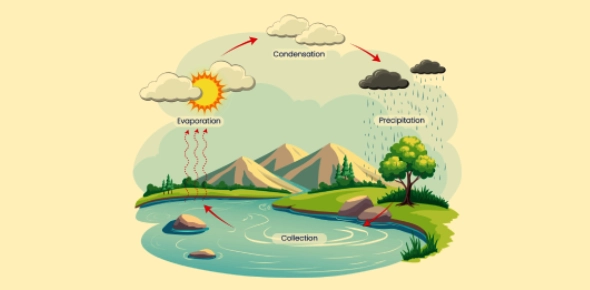Water Cycle: Key Concepts, Main Phases, and Impact on the Environment
Lesson Overview
What Is the Water Cycle?
Communities facing water shortages or unpredictable rainfall often struggle to manage resources sustainably. These issues are rooted in a limited understanding of how water moves through our environment. This water cycle lesson explains key concepts, major phases, and the environmental impact-offering a clear foundation for solving real-world water challenges.

Why Is the Water Cycle Important?
The water cycle is essential because it regulates the continuous movement of water within Earth's atmosphere, surface, and underground systems-sustaining life and shaping the environment. Here's why it matters:
1. Supports All Life Forms
Water is vital for all organisms, and the water cycle ensures its continuous availability. Plants absorb water through roots, animals drink it, and humans rely on it for agriculture, hygiene, and industry.
2. Maintains Climate Balance
By redistributing heat through processes like evaporation and condensation, the water cycle helps regulate Earth's temperature and climate. For example, evaporation cools surfaces, while condensation releases heat into the atmosphere.
3. Purifies Natural Water Sources
As water evaporates, it leaves behind impurities. When it condenses and falls as precipitation, it's relatively clean. This natural distillation process replenishes freshwater in rivers, lakes, and groundwater.
4. Drives Weather Patterns
Rain, snow, fog, and storms all result from different stages of the water cycle. The interaction between the sun's heat and moisture in the air directly influences local and global weather conditions.
5. Facilitates Plant Growth and Agriculture
Through precipitation and soil absorption, the cycle delivers essential water to crops and vegetation. This supports food production and natural ecosystems across biomes.
6. Recharges Groundwater and Surface Water
The infiltration of rainwater replenishes underground aquifers, while runoff feeds lakes and rivers. These sources are critical for drinking water, irrigation, and energy production (e.g., hydroelectricity).
7. Controls Natural Hazards
Understanding the water cycle helps predict and manage floods, droughts, and hurricanes. Monitoring precipitation and runoff patterns enables better disaster preparedness and water conservation.
Take These Quizzes
What Are the Key Processes of the Water Cycle?
The water cycle operates through a series of continuous, natural processes that move water through the atmosphere, land, and oceans. These processes ensure the circulation, purification, and distribution of water across the Earth. The key processes include:
Evaporation
Water from oceans, rivers, lakes, and soil turns into vapor due to heat from the sun. This vapor rises into the atmosphere, beginning the cycle. Evaporation also includes transpiration, where plants release water vapor from their leaves-a combined process often called evapotranspiration.
Condensation
As water vapor rises and cools in the atmosphere, it changes back into liquid droplets, forming clouds. This transformation from gas to liquid is called condensation. It is essential for cloud formation and weather development.
Precipitation
When cloud droplets combine and become too heavy, they fall to the ground as precipitation-rain, snow, sleet, or hail. This process returns water to Earth's surface and feeds rivers, lakes, and groundwater.
Collection (Accumulation)
Fallen precipitation collects in various water bodies like oceans, rivers, lakes, and glaciers. Some of it runs off the land into surface water, while some infiltrates the soil.
Infiltration
Some of the water that hits the ground soaks into the soil. This is called infiltration. The water moves downward through the soil and may recharge underground aquifers, forming groundwater.
Runoff
Water that does not infiltrate the ground flows over the land surface as runoff, eventually reaching streams, rivers, and oceans. Runoff plays a role in shaping landscapes and transporting nutrients.
Sublimation and Deposition (less common but important)
Sublimation is when solid ice or snow changes directly into water vapor without becoming liquid. Deposition is the reverse-water vapor turns directly into ice. These processes usually occur in very cold regions and contribute to atmospheric moisture.
Take These Quizzes
How Do Humans Impact the Water Cycle and What Are the Strategies for Water Conservation?
Human activity has significantly altered the natural flow and balance of the water cycle. From urban development to agriculture and industrial processes, these actions affect how water moves, is stored, and replenished across ecosystems. At the same time, effective strategies for water conservation can help mitigate these impacts and restore ecological balance.
Human Impacts on the Water Cycle
Urbanization
As cities expand, natural surfaces are replaced with concrete and asphalt, reducing infiltration and increasing surface runoff. This leads to lower groundwater recharge and higher flood risks. Rainwater that once soaked into soil now moves quickly into storm drains and rivers, disrupting local water availability.
Deforestation
The removal of forests decreases transpiration, alters rainfall patterns, and reduces soil stability. Without tree roots to absorb and retain water, runoff increases, leading to erosion, flash floods, and reduced groundwater recharge.
Agriculture
Intensive farming uses large volumes of water for irrigation, often diverting water from rivers and aquifers. Excessive withdrawal can lower water tables. Overuse of fertilizers and pesticides also contaminates water bodies, affecting water quality in the cycle.
Industrial Activity
Factories and power plants consume vast amounts of water for cooling and processing. Many industrial activities pollute water through discharge of chemicals and thermal pollution, harming aquatic ecosystems and altering natural evaporation and condensation rates.
Climate Change
By increasing global temperatures, human-induced climate change accelerates evaporation, disrupts precipitation patterns, and intensifies extreme weather events. Some regions experience more droughts, while others face heavier rainfall and flooding.
Groundwater Depletion
Over-pumping groundwater for drinking, agriculture, and industry reduces aquifer levels faster than they can be naturally recharged, leading to land subsidence and long-term water scarcity.
Strategies for Water Conservation
Rainwater Harvesting
Collecting rainwater from rooftops or other surfaces for household or irrigation use reduces dependence on groundwater and municipal supplies. It also reduces runoff and helps recharge local aquifers.
Efficient Irrigation Techniques
Using methods like drip irrigation and soil moisture sensors minimizes water waste in agriculture. These systems deliver water directly to plant roots, conserving water while maintaining crop yield.
Water Recycling and Reuse
Reusing treated wastewater for landscaping, industrial cooling, or flushing toilets can reduce the need for fresh water. Greywater systems are increasingly used in residential and commercial buildings.
Forest and Wetland Restoration
Protecting and restoring forests and wetlands enhances natural infiltration, flood regulation, and water purification. These ecosystems act as buffers and reservoirs within the water cycle.
Urban Green Infrastructure
Constructing green roofs, permeable pavements, and bioswales in urban areas improves water absorption and reduces runoff. These methods also support local biodiversity and reduce heat island effects.
Reducing Pollution at Source
Proper treatment of industrial waste, reducing fertilizer use, and promoting environmentally friendly farming practices help protect the quality of surface and groundwater in the cycle.
Public Awareness and Education
Educating communities about the importance of water conservation encourages responsible use. Campaigns, school programs, and policy incentives can change consumption habits at scale.
Regulatory Policies and Monitoring
Enforcing water-use regulations, metering, and pricing structures encourages conservation. Monitoring systems help detect overuse, leakage, and pollution early.
Take These Quizzes
Conclusion
Throughout this water cycle lesson, we have delved into the intricate workings of the water cycle, a fundamental process that sustains life on Earth by regulating climate, distributing water, and supporting ecosystems. By understanding the key processes of the water cycle-evaporation, transpiration, condensation, precipitation, and infiltration-we gain insight into how water moves through different spheres of the Earth and influences everything from local weather patterns to global climate systems.
Rate this lesson:
 Back to top
Back to top


(188).jpg)

.webp)
(189).jpg)
.webp)

